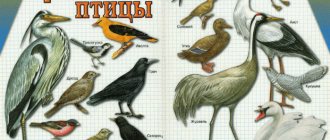Natural enemies
The nimble, swift and secretive cuckoos have very few enemies. Sometimes they may be attacked by other birds in order to defend the territory. But the greatest danger is posed by foxes, cats, weasels and martens.
Photo: rasfokus.ru
Waxwing (60 photos): description of the bird, where it lives and what it eats
Eggs
Cuckoo eggs in the nest
The incubation period lasts 12 days. Cuckoo eggs look larger than the eggs of parent birds. The color of the shell is varied. Some eggs are white with brown specks, some are bluish-green, dirty yellow, dark brown.
Some species of cuckoos lay eggs similar in size and color to the eggs of parent birds. Cuckoos that parasitize the nests of sparrows, wagtails or warblers lay small, light brown eggs. Cuckoos, which prefer the nests of crows and magpies, lay larger eggs. Cuckoo eggs can be found in the nests of passerine birds, as well as birds belonging to the hawk-like family. Most often, the cuckoo parasitizes the nests of redstarts, warblers, tiny kinglets, wrens, nightingales, swifts, sparrows, etc. The number of parent species reaches 300. Many cuckoos parasitize one species of bird. Some species lay chaotically, without understanding which species of bird this or that nest belongs to.
Lifestyle and habitat
Birds have chosen many habitats, covering almost the entire globe, except Antarctica and Antarctica. Cuckoos spread massively across the American continent and Eurasia.
Birds are attracted to the warm climate and areas with extensive deciduous forests. They do not like dense taiga with impenetrable thickets of dark coniferous plants. In many sparse forests, most species of cuckoos have colonized the upper layers of trees, only a few have settled in the forest-steppe. Evolution has gradually adapted birds to open spaces.
determine whether a cuckoo is a migratory bird or not by looking at its nesting site. Those species that hatch their chicks in the temperate zone fly to Africa, China, and India for the winter. Birds of North America migrate to Argentina.
During seasonal migrations, cuckoos travel more than 3,000 km without rest; the total distance from nesting sites reaches 6,000 km. Tracking migrations is difficult due to the secretive nature of the birds. Cuckoos do not flock together.
They fly slowly, conserving their strength. Wintering in the southern regions lasts approximately 3 months. In the tropics, the cuckoo is a wintering , sedentary bird.
Despite the prevalence of cuckoos, they are difficult to observe. They lead a solitary life, only breeding time attracts them to each other. Birds know the forest and the birds inhabiting it very well. The survey of the territory is measured in hectares.
As a nesting parasite, the mysterious cuckoo bird selects foster parents for its offspring. Hundreds of bird species became unwilling guardians. The cuckoo itself does not bother building a nest or caring for the chicks. It is no coincidence that the name of the bird has become a household name for grief-stricken mothers who abandoned their own children.
Among the numerous species there are many tropical cuckoos that are quite capable of feeding and raising offspring. Therefore, all birds should not be considered parasites. The social benefit of birds is the destruction of forests and gardens from harmful insects and caterpillars.
Spreading
The cuckoo scares other birds.
The distribution range of cuckoos is extensive. There are more than 150 species of birds in the world, living in Eurasia, Africa, Indonesia, and Asia. Cuckoos are found in America and the Pacific Islands. The only exception is the Arctic latitudes. The cuckoo is an unpretentious bird. It takes root in the tropics, temperate latitudes and even the tundra. Common cuckoos live in Europe and Russia, India, China and Japan. In winter they nest in Africa, southern India and southern China.
Nutrition
The diet of omnivorous cuckoos mainly consists of a variety of organisms, but also includes plant foods. Despite their small size, the birds are very voracious. This is due to the accumulation of subcutaneous fat, necessary for long-distance flights during winter migration.
Their favorite food consists of grasshoppers, grasshoppers, beetles, butterflies, cabbage worms, and small lizards. Cuckoos feast on mosquitoes, ant and bird eggs, pupae, insect larvae, and poisonous hairy caterpillars that other birds avoid. Among plant foods, forest cuckoos prefer berries.
The destruction of huge numbers of insects by birds is an important factor in protecting the ecosystem. Only during the breeding season does the appetite of forest orderlies decrease. The life of a cuckoo bird is filled with active searches for a mate to breed.
The phenomenon of nest parasitism
No more than 50 species of cuckoos engage in parasitism. This phenomenon had no scientific basis for a long time. Among other things, these birds have a wide variety of strategies for rearing their offspring. The first step on the path to parasitism is considered to be the variant of communal nesting, which is demonstrated by the cuckoo Ani. This species is notable for the fact that several pairs create a collective home in which all pairs lay eggs. Next, the birds take turns incubating the eggs.
All adults are involved in feeding the chicks: both males and females. This option has its drawbacks, since a large number of eggs die due to the fact that they do not have enough heat due to the fact that they were hatched by one adult. The next step towards nest parasitism is considered to be the behavior of the guira, which only when there is a lack of places to throw their descendants of birds of their own species. If the red-eyed cuckoo could not find the nest, it does not limit itself to its relatives and throws eggs to other species of birds.
In addition, Galapagos representatives of the family lay their eggs in others’ eggs, and then expel the owners from them. In the full sense, this cannot be called parasitism, since the bird itself feeds its offspring. Known for its beautiful plumage, the bronze cuckoo is the next step on the path to parasitism, as it deposits its young in the nests of weavers. However, after the chicks fly out, the cuckoo begins to bring food to the cuckoo chick, supplementing it with food.
Interesting Facts
Cuckoo among flowers
- Scorpion venom is harmless to cuckoos
- During the migration period, the cuckoo travels 3.5 thousand kilometers without rest.
- One of the symbols of Russia is the cuckoo clock.
- In Scotland, April Fools' Day (April 1st) is also called Cuckoo Day.
- In Japan, the cuckoo symbolizes misfortune. Her piercing cry foreshadows fire, famine and death.
- In Russia there is a belief: the number of times a cuckoo crows, the number of years it has left to live.
- Grief mothers are compared to a cuckoo: a woman abandoned her child - she did the same thing as a bird.
Chicks at home
The cuckoo chick fell out of the nest.
Grown cuckoo chicks show interest in the world around them and often fall out of the nest. the lost chicks become prey for mammals, since the adoptive parents do not rush to help.
A selected cuckoo can be raised at home. It is known that
Cuckoos are insectivorous birds. They need to be fed animal food. IN
In the wild, the main diet consists of caterpillars. The young eat a lot and often. IN
per day it eats up to 50 caterpillars. And he asks to eat every half hour. In captivity they cuckoo
fed with mealworms, which are sold in pet stores. If there is no usual
for birds food, then give minced meat mixed with a raw egg, liquid food for
dogs and cats. canned food
The chicks do not care who is their breadwinner. they open their mouths with pleasure as soon as a person approaches.
By the month of life, the chick will learn to get food on its own. As soon as he gets on the wing,
he should be released. As a rule, cuckoos cannot be tamed.
Having matured, the bird will immediately fly away to freedom.
Description and features
Ancient authors were the first to point out the similarity in the external characteristics of the cuckoo and the hawk. Aristotle associated the similarity with a belief in which a creature prone to reincarnation had two appearances. Scientists note the common head shape, plumage pattern, and flight characteristics of birds.
The size of the bird is comparable to the size of a medium-sized pigeon. The length is 33-34 cm, weight 100-180 g, wingspan 56-65 cm. The forest cuckoo in the photo shows an elegant build. The long wedge-shaped tail and short wings allow it to maneuver perfectly in the thickets.
When the cuckoo sits, the short legs are almost invisible. Like woodpeckers, the arrangement of fingers: two in front, two behind, allows you to hold firmly on a vertical surface, but prevents walking on a horizontal surface.
The beak of cuckoos is black, with a slight yellow tint below. Around the eyes there is a leathery ring of a bright orange hue.
The color of common cuckoos is predominantly dark gray with an ashen tint. The abdomen is light, with a transverse steel stripe. Birds' legs are always yellow. Sexual differences are almost invisible, but sometimes there are females of a white-red color with transverse streaks.
Juveniles are always more multi-colored, distinguished by a gray-brown-red color scheme, with white spots on the back of the head, which disappear in adult birds. Birds moult twice a year. Partial renewal of feathers is observed in the summer, and complete renewal in the winter.
Depending on the type of bird, the color varies markedly. Thus, bronze cuckoos have the appropriate shade for reliable camouflage. The golden cuckoo has yellow-beige plumage with dark speckles.
The bird leads a secretive lifestyle, rarely indicating its presence with sounds. The exception is spring and the first half of summer, when mating time turns males into noisy and vociferous singers. The repeatedly repeated call “ku-ku” with intensification on the first syllable is aimed at attracting a female.
Listen to the voice of the cuckoo
On clear days, the voice of the cuckoo can be heard at a distance of two kilometers. If the bird is excited, then the measured sounds seem to combine into a single “ku-ku-ku-ku”, similar to clucking or laughter. The female also makes calling calls, similar to a gurgling trill. If caught birds are picked up, they squeal loudly.







